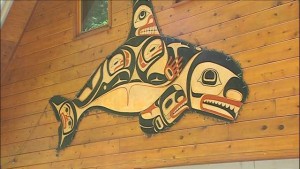 SAN JUAN ISLAND, WASHINGTON – It’s an image you often see on paintings and wood carvings – a giant totemic killer whale, with the images of sea creatures and faces artistically contained within the whale’s body.
SAN JUAN ISLAND, WASHINGTON – It’s an image you often see on paintings and wood carvings – a giant totemic killer whale, with the images of sea creatures and faces artistically contained within the whale’s body.
The image tells the story of the Tlingit legend of the creation of the killer whale, which goes as follows: Natsilane was a charismatic and skilled wood carver who married the Chief’s daughter. Jealous of Natsilane’s popularity and talent, his brothers-in-law devised a plan to abandon Natsilane at sea during a traditional sea lion hunt. Left to die on a small rock in the middle of nowhere, Natsilane was summoned under the waves by a sea lion. The sea lion asked him to heal his son who was injured by a spear during the hunt. After pulling the spear point out, the Sea Lion Chief granted Natsilane great powers and helped him back to shore. Still angry about being abandoned, he began carving a great whale out of different types of wood. The first two carvings, when set in the water, simply floated away. But the third, made of yellow cedar, came to life. Natsilane sent it to exact revenge on his brothers-in-law. When the killer whale found them, he smashed their canoe and killed the brothers. But Natsilane felt badly about what he had done, and when the whale returned to him, he instructed it to never harm humans again.
WATCH: 'Extremely Rare' 2-Headed Snake Shocks Scientists
The legend tries to explain something curious about orcas. They don’t attack people. The question is -- why not? On a simple, biological scale they are bigger and stronger than we are, have sharper teeth, and they’re carnivores. Any similar creature might see humans as a tasty little snack, but not orcas.
Observation has shown that one answer may not be far from the ancient legend. Killer whales seem to follow rules that go beyond basic instinct and border on culture. Individual pods forage, communicate and navigate differently, much the way different cultures of people do. Researchers have witnessed “greeting ceremonies” between pods. They’ve even seen the equivalent of a funeral. It may very well be that within “orca culture” there is a social norm not to go after people.